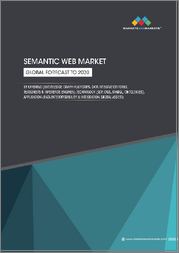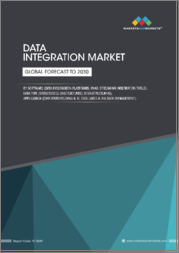
|
시장보고서
상품코드
1658026
데이터 통합 시장 규모, 점유율, 성장 분석 : 구성요소별, 전개별, 조직 규모별, 최종사용자별, 지역별 - 산업 예측(2025-2032년)Data Integration Market Size, Share, and Growth Analysis, By Component (Tools, Services), By Deployment (Cloud, On-premise), By Organization Size, By End-user, By Region - Industry Forecast 2025-2032 |
||||||
데이터 통합 시장 규모는 2023년 150억 달러로 평가되며, 예측 기간(2025-2032년) 동안 12.2%의 CAGR로 2024년 168억 3,000만 달러에서 2032년 422억 7,000만 달러로 성장할 것으로 예상됩니다.
데이터 통합은 비즈니스 효율성을 높이고 오늘날의 시장에서 경쟁 우위를 확보하고자 하는 기업에게 필수적입니다. 추출, 변환, 로드 등의 프로세스를 통해 다양한 소스의 데이터를 중앙 집중식 뷰로 통합함으로써 기업은 종합적인 비즈니스 인텔리전스 인사이트를 확보할 수 있습니다. 이러한 중앙 집중식 데이터는 의사결정에 큰 영향을 미치며, 기업은 가장 관련성이 높은 정보를 즉시 찾아 활용할 수 있습니다. 또한, 통합 프로세스로 구축된 데이터 웨어하우스는 부서 간 원활한 지식 전달을 촉진하고 시스템 간 협업을 촉진합니다. 기업들은 효과적인 데이터 통합이 데이터 자산의 가치를 극대화하고, 일관성을 실현하고, 업무를 간소화하고, 실용적인 인사이트를 활용하여 현대 경제에서 보다 유리한 위치를 차지할 수 있는 열쇠라는 사실을 점점 더 많이 인식하고 있습니다.
목차
소개
- 조사 목적
- 조사 범위
- 정의
조사 방법
- 정보 조달
- 2차와 1차 데이터 방법
- 시장 규모 예측
- 시장 가정과 제한
주요 요약
- 세계 시장 전망
- 공급과 수요 동향 분석
- 부문별 기회 분석
시장 역학과 전망
- 시장 개요
- 시장 규모
- 시장 역학
- 성장 촉진요인과 기회
- 성장 억제요인과 과제
- Porters 분석
주요 시장 인사이트
- 핵심성공요인
- 경쟁 정도
- 주요 투자 기회
- 시장 생태계
- 시장 매력 지수(2024년)
- PESTEL 분석
- 거시경제 지표
- 밸류체인 분석
- 가격 분석
- 기술의 진보
- 규제 상황
- 특허 분석
데이터 통합 시장 규모 : 구성요소별 & CAGR(2025-2032년)
- 시장 개요
- 툴
- 서비스
데이터 통합 시장 규모 : 전개별 & CAGR(2025-2032년)
- 시장 개요
- 클라우드
- 온프레미스
데이터 통합 시장 규모 : 조직 규모별 & CAGR(2025-2032년)
- 시장 개요
- 대기업
- 중소기업
데이터 통합 시장 규모 : 최종사용자별 & CAGR(2025-2032년)
- 시장 개요
- BFSI
- 헬스케어
- 소매
- IT 및 통신
- 정부
- 제조업
- 기타
데이터 통합 시장 규모 : 지역별 & CAGR(2025-2032년)
- 북미
- 미국
- 캐나다
- 유럽
- 독일
- 스페인
- 프랑스
- 영국
- 이탈리아
- 기타 유럽
- 아시아태평양
- 중국
- 인도
- 일본
- 한국
- 기타 아시아태평양
- 라틴아메리카
- 브라질
- 기타 라틴아메리카
- 중동 및 아프리카
- GCC 국가
- 남아프리카공화국
- 기타 중동 및 아프리카
경쟁 정보
- 상위 5개사의 비교
- 주요 기업의 시장 포지셔닝(2024년)
- 주요 시장 기업이 채용한 전략
- 최근의 시장 동향
- 기업의 시장 점유율 분석(2024년)
- 주요 기업 개요
- 기업 상세
- 제품 포트폴리오 분석
- 기업 부문별 점유율 분석
- 매출 전년비 비교(2022-2024년)
주요 기업 개요
- SAP SE(Germany)
- IBM Corporation(USA)
- Microsoft Corporation(USA)
- Oracle Corporation(USA)
- Informatica(USA)
- SAS Institute(USA)
- TIBCO Software(USA)
- Software AG(Germany)
- Precisely(USA)
- Denodo Technologies(USA)
- Hitachi Vantara Corporation(Japan)
- Cisco Systems(USA)
- Salesforce(USA)
- Amazon Web Services(USA)
- Alphabet Inc.(USA)
- Adeptia(USA)
- SnapLogic(USA)
- KPMG LLP(Netherlands)
결론과 제안
ksm 25.03.26Data Integration Market size was valued at USD 15.0 billion in 2023 and is poised to grow from USD 16.83 billion in 2024 to USD 42.27 billion by 2032, growing at a CAGR of 12.2% during the forecast period (2025-2032).
Data integration is essential for businesses looking to enhance their operational efficiency and gain a competitive edge in today's market. By merging data from diverse sources into a centralized view through processes like extraction, transformation, and loading, organizations can access comprehensive business intelligence insights. This centralized data can significantly inform decision-making, allowing companies to locate and utilize the most relevant information readily. Furthermore, data warehouses built from the integration process facilitate seamless knowledge transfer across departments, promoting intersystem collaboration. As businesses increasingly recognize that effective data integration is key to maximizing the value of their data assets, they can achieve consistency, streamline operations, and leverage actionable insights, ultimately positioning themselves more favorably in the modern economy.
Top-down and bottom-up approaches were used to estimate and validate the size of the Data Integration market and to estimate the size of various other dependent submarkets. The research methodology used to estimate the market size includes the following details: The key players in the market were identified through secondary research, and their market shares in the respective regions were determined through primary and secondary research. This entire procedure includes the study of the annual and financial reports of the top market players and extensive interviews for key insights from industry leaders such as CEOs, VPs, directors, and marketing executives. All percentage shares split, and breakdowns were determined using secondary sources and verified through Primary sources. All possible parameters that affect the markets covered in this research study have been accounted for, viewed in extensive detail, verified through primary research, and analyzed to get the final quantitative and qualitative data.
Data Integration Market Segments Analysis
Global Data Integration Market is segmented by Component, Deployment, Organization Size, End-user and region. Based on Component, the market is segmented into Tools and Services. Based on Deployment, the market is segmented into Cloud and On-premise. Based on Organization Size, the market is segmented into Large Enterprises and Small and Medium-sized Enterprises (SMEs). Based on End-user, the market is segmented into BFSI, Healthcare, Retail, IT and Telecom, Government, Manufacturing and Others. Based on region, the market is segmented into North America, Europe, Asia Pacific, Latin America and Middle East & Africa.
Driver of the Data Integration Market
The rapid increase of connected devices within the Internet of Things (IoT) landscape generates substantial amounts of sensor data. Effectively integrating this data into existing organizational systems is essential for gaining insights into operational efficiency, product performance, and customer behavior trends. To harness the complete advantages of the IoT revolution, data integration solutions play a pivotal role. They enable businesses to unify and analyze diverse data streams, leading to improved decision-making and enhanced performance across various sectors. As companies recognize the importance of data integration in maximizing their IoT investments, the demand for robust integration solutions continues to grow.
Restraints in the Data Integration Market
One of the significant constraints in the data integration market is the necessity for skilled professionals to implement and manage these solutions effectively. Organizations require individuals who possess expertise in data modeling, data governance, and familiarity with various integration tools. Unfortunately, the demand for such knowledgeable professionals far exceeds the current availability of skilled workers in this field. This shortage complicates the hiring process and poses challenges for businesses striving to maintain a competent workforce capable of leveraging data integration solutions effectively. As a result, companies may face difficulties in fully realizing the benefits of these technologies.
Market Trends of the Data Integration Market
The Data Integration market is witnessing a significant trend towards robust data security measures as organizations increasingly prioritize safeguarding sensitive information amid rising cyber threats. With the proliferation of industrial automation and IoT applications, companies are seeking to streamline operations while ensuring data integrity and compliance. This heightened focus on security has led to a surge in demand for advanced integration solutions that not only connect disparate data sources but also incorporate encryption, access controls, and real-time monitoring. As businesses recognize the critical importance of securing their data ecosystems, the Data Integration market is poised for substantial growth and innovation in security features.
Table of Contents
Introduction
- Objectives of the Study
- Scope of the Report
- Definitions
Research Methodology
- Information Procurement
- Secondary & Primary Data Methods
- Market Size Estimation
- Market Assumptions & Limitations
Executive Summary
- Global Market Outlook
- Supply & Demand Trend Analysis
- Segmental Opportunity Analysis
Market Dynamics & Outlook
- Market Overview
- Market Size
- Market Dynamics
- Drivers & Opportunities
- Restraints & Challenges
- Porters Analysis
- Competitive rivalry
- Threat of substitute
- Bargaining power of buyers
- Threat of new entrants
- Bargaining power of suppliers
Key Market Insights
- Key Success Factors
- Degree of Competition
- Top Investment Pockets
- Market Ecosystem
- Market Attractiveness Index, 2024
- PESTEL Analysis
- Macro-Economic Indicators
- Value Chain Analysis
- Pricing Analysis
- Technology Advancement
- Regulatory Landscape
- Patent Analysis
Global Data Integration Market Size by Component & CAGR (2025-2032)
- Market Overview
- Tools
- Services
Global Data Integration Market Size by Deployment & CAGR (2025-2032)
- Market Overview
- Cloud
- On-premise
Global Data Integration Market Size by Organization Size & CAGR (2025-2032)
- Market Overview
- Large Enterprises
- Small and Medium-sized Enterprises (SMEs)
Global Data Integration Market Size by End-user & CAGR (2025-2032)
- Market Overview
- BFSI
- Healthcare
- Retail
- IT and Telecom
- Government
- Manufacturing
- Others
Global Data Integration Market Size & CAGR (2025-2032)
- North America (Component, Deployment, Organization Size, End-user)
- US
- Canada
- Europe (Component, Deployment, Organization Size, End-user)
- Germany
- Spain
- France
- UK
- Italy
- Rest of Europe
- Asia Pacific (Component, Deployment, Organization Size, End-user)
- China
- India
- Japan
- South Korea
- Rest of Asia-Pacific
- Latin America (Component, Deployment, Organization Size, End-user)
- Brazil
- Rest of Latin America
- Middle East & Africa (Component, Deployment, Organization Size, End-user)
- GCC Countries
- South Africa
- Rest of Middle East & Africa
Competitive Intelligence
- Top 5 Player Comparison
- Market Positioning of Key Players, 2024
- Strategies Adopted by Key Market Players
- Recent Developments in the Market
- Company Market Share Analysis, 2024
- Company Profiles of All Key Players
- Company Details
- Product Portfolio Analysis
- Company's Segmental Share Analysis
- Revenue Y-O-Y Comparison (2022-2024)
Key Company Profiles
- SAP SE (Germany)
- Company Overview
- Business Segment Overview
- Financial Updates
- Key Developments
- IBM Corporation (USA)
- Company Overview
- Business Segment Overview
- Financial Updates
- Key Developments
- Microsoft Corporation (USA)
- Company Overview
- Business Segment Overview
- Financial Updates
- Key Developments
- Oracle Corporation (USA)
- Company Overview
- Business Segment Overview
- Financial Updates
- Key Developments
- Informatica (USA)
- Company Overview
- Business Segment Overview
- Financial Updates
- Key Developments
- SAS Institute (USA)
- Company Overview
- Business Segment Overview
- Financial Updates
- Key Developments
- TIBCO Software (USA)
- Company Overview
- Business Segment Overview
- Financial Updates
- Key Developments
- Software AG (Germany)
- Company Overview
- Business Segment Overview
- Financial Updates
- Key Developments
- Precisely (USA)
- Company Overview
- Business Segment Overview
- Financial Updates
- Key Developments
- Denodo Technologies (USA)
- Company Overview
- Business Segment Overview
- Financial Updates
- Key Developments
- Hitachi Vantara Corporation (Japan)
- Company Overview
- Business Segment Overview
- Financial Updates
- Key Developments
- Cisco Systems (USA)
- Company Overview
- Business Segment Overview
- Financial Updates
- Key Developments
- Salesforce (USA)
- Company Overview
- Business Segment Overview
- Financial Updates
- Key Developments
- Amazon Web Services (USA)
- Company Overview
- Business Segment Overview
- Financial Updates
- Key Developments
- Alphabet Inc. (USA)
- Company Overview
- Business Segment Overview
- Financial Updates
- Key Developments
- Adeptia (USA)
- Company Overview
- Business Segment Overview
- Financial Updates
- Key Developments
- SnapLogic (USA)
- Company Overview
- Business Segment Overview
- Financial Updates
- Key Developments
- KPMG LLP (Netherlands)
- Company Overview
- Business Segment Overview
- Financial Updates
- Key Developments



















